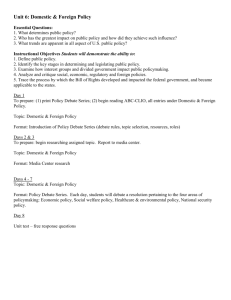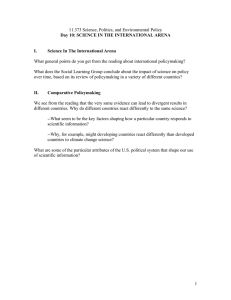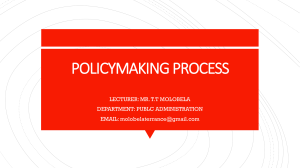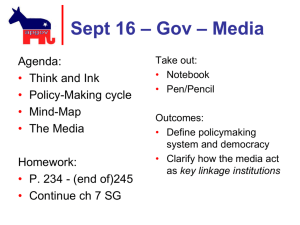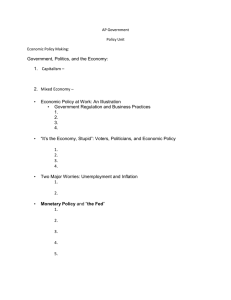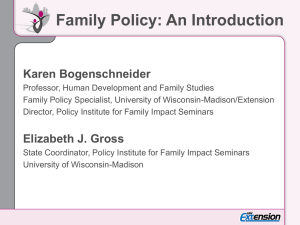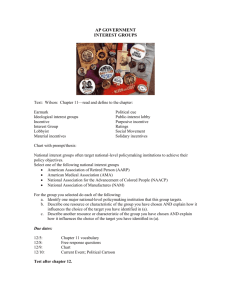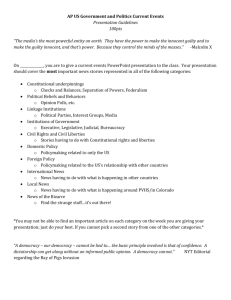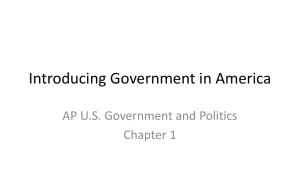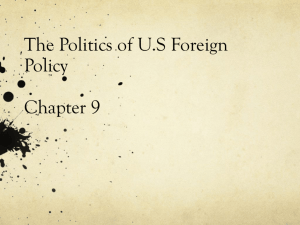Document 9215975
advertisement
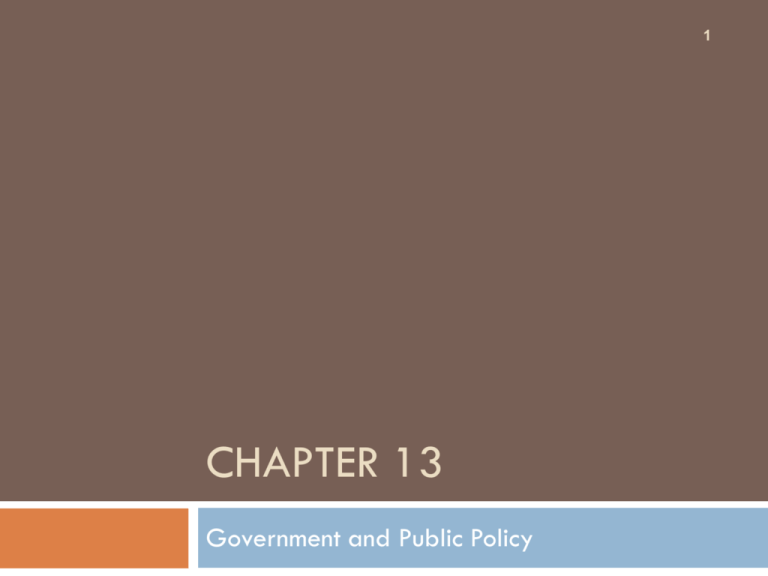
1 CHAPTER 13 Government and Public Policy Public Policy in the Political Process 2 Conflict Over the Ends of Government policy is “whatever government chooses to do or not to do.” Public Debates over procedures and rules are really debates over policy. The results of public policy mirror conflicts in demands. This is because of varying consequences for different groups. Even policies designed to protect the common good may have consequences. Selected Perspectives on Policymaking 3 Given the complexity of making policy and the sharp conflicts that can drive policy debate, a variety of models, interpretations, and approaches have been offered as portraits of how policy is or should be made. Perspectives on Policymaking 4 Several models or explanations of policymaking have been proposed. The systems model The bureaucratic model Holds that bureaucracies play a crucial role in making policy because of their commitment and the expertise they can provide The Marxism model Holds that policy is the product of an interlocking relationship between institutions of government and its social, economic, and political environment Holds that public policy decisions in non-Marxist regimes reflect the interest of the ruling economic class at the expense of the workers The free market capitalism model Holds that government plays a limited role, and therefore the natural forces of supply and demand are allowed to prevail in the marketplace The Systems Model of Policymaking 5 The systems model describes policymaking in terms of the relationship between a political system and its environment. “Inputs” (demands and supports) are converted into “outputs” (policy decisions). By affecting the environment of the political system, these outputs may generate new inputs. Who makes policy decisions? 6 According to the elitism model, public policy decisions are made by a relatively small group of individuals acting in their own self-interest rather than in the interest of the mass citizens. According to the pluralism model, public policy decisions are the result of struggle among contesting groups that reflect the various interests among citizens. How are policy decisions made? In the rational-comprehensive model, policymakers identify problems, consider various policy alternatives and their costs and benefits, and select and implement the policy strategy with the highest benefits and the lowest cost. Incrementalism is an alternative model that holds that new policies should differ only marginally from existing policies. Incrementalism and Social Security Tax Rates 7 The creation of the Social Security program in 1935 was a fundamental change in government policy. Once Social Security was established, changes in the rates of taxes to pay for the program occurred in incremental steps over time. Short of an emergency of the magnitude of the Great Depression, it is unlikely that there will be any drastic and abrupt changes in the program. Rather, adjustments will come gradually. Stages in the Policy Process 8 The policy process can be a confusing clash of ideas, events, and personalities. Five stages in the evolution of policies help make sense out of a seemingly confusing and chaotic process. Getting Issues on the Agenda of Government The policy agenda is comprised of the list of issues that engage the attention of elected officials. The issues on the policy agenda are always changing. Different sets of issues have dominated the policy agenda at different times. Formulating Policy Proposals In this stage, debate centers around policy strategy, a course of action designed to deal with the original problem. What government should do, who should benefit, and who should bear the costs comprise the material of policy debate. Stages in the Policy Process (continued) 9 Formulating Policy Proposals Adopting Policy Proposals Policy adoption occurs when the institutions of government make a formal, authoritative decision. Formal adoption may occur through the passage of a bill, a Supreme Court decision, or a bureaucratic regulation. Implementing Policies In this stage, debate centers around policy strategy, a course of action designed to deal with the original problem. What government should do, who should benefit, and who should bear the costs comprise the material of policy debate. Bureaucracies are ultimately responsible for policy implementation, translating policy ideas into action. Evaluating Policies Policy evaluation determines whether the formally adopted, implemented strategy actually fixed the originally defined problem. Stages in the Policy Process (continued) 10 Although policies do not always develop in the neatly defined steps outlined here, an awareness of what happens in each step helps us understand the process that occurs as government attempts to solve problems and accomplish goals. Any number and combination of persons and events can bring concerns to the attention of political leaders (step 1). Policymakers in the executive and legislative branches then study the range of choices open to them to meet those concerns (step 2). A variety of public officials may be involved in selecting a course of action or in deciding to do nothing at all (step 3). The policy then becomes the responsibility of bureaucrats to administer (step 4). Finally, evaluation occurs. Does the plan work? Is it worth its costs (step 5)? The evaluation may become a factor in encouraging further policymaking by government. The Purposes and Presence of the National Government 11 There are two basic policy categories: Domestic policy Foreign policy The presence or absence of economic self-interest is another useful criterion for differentiating policies. Categories of National Government Policies Foreign and defense policies are among the oldest functions of the national government. The most significant policy growth over the past half-century has occurred in the category of Social Welfare. The Purposes and Presence of the National Government (continued) 12 Protection of legal and constitutional rights is exemplified by Supreme Court decisions protecting individual and group rights and congressional legislation on civil and voting rights. Promotion of science and technology has become government policy in such areas as the space program and medical research. The Purposes and Presence of the National Government (continued) 13 Regulation by government is intended to structure relationships in certain industries or enhance the political and economic status of certain groups. Economic policies have their roots in the early days of the Republic and continue to have a huge impact through budget, tax, employment, investment, and other types of policies.
